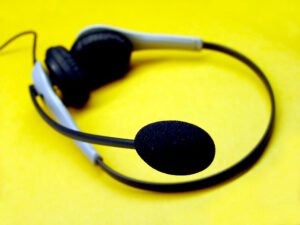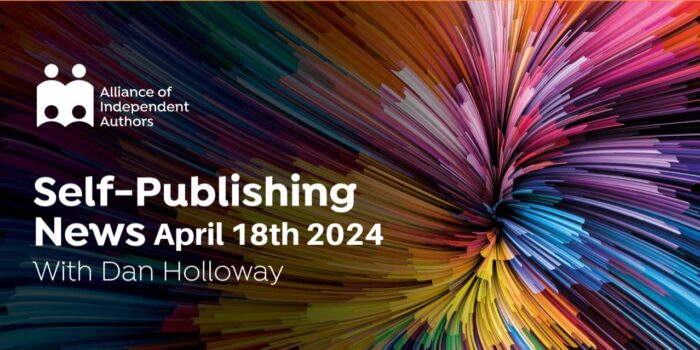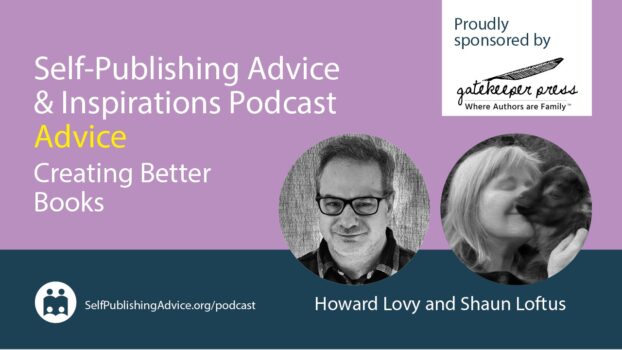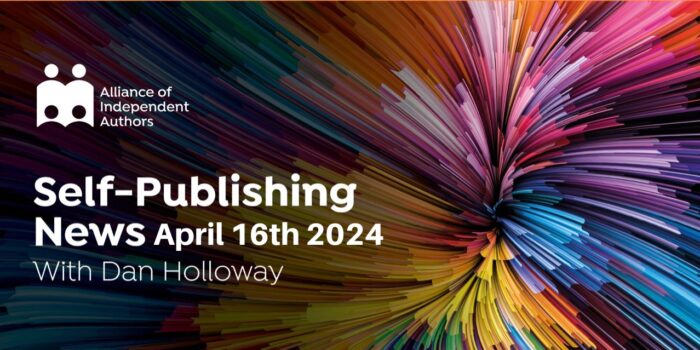The latest generation of voice recognition software can be an invaluable tool for indie authors, whether you are writing full-time or trying to make the most of limited time available. Even if you have been deterred by disappointing experiences with earlier packages, it's worth trying the latest software to see whether it can help you improve your productivity.
I was first persuaded to use voice recognition software by ALLi director Orna Ross, who reports:
“I can definitely say that I would achieve about one third of what I do without it. I'm using it to “write” this comment and almost all the writing I do each day (a few thousand words on average, between one thing and another). I like to write fiction and poetry by hand, pen and paper, and then transcribe using Dragon. Non-fiction, emails and other less literary writing, I just talk in direct. It can manage my Irish accent so I reckon can manage most! It's definitely my very, very best writing friend.”
As a relatively recent convert to using voice recognition software, I've had a positive experience so far, using Nuance's Dragon (Windows version) and the Google system that was included with my new tablet.
I had a specific reason to try it: I have rheumatoid arthritis, which occasionally makes my hands swollen and painful. Although I'm a very fast touch-typist, the prospect of being able to churn out copious copy without moving my hands was appealing.
Improving Accuracy
I was slightly sceptical of how helpful it might be, having often chuckled at inaccurate subtitles on news programmes. Yet once I'd started “training my Dragon” i.e. acclimatizing it to the idiosyncrasies of my voice (softly spoken with a south-east London accent), I was pleasantly surprised at how accurate and how fast it was. Even after a relatively short period of use, I was able me to rattle away and create a satisfactory first draft. Of course, I then had to fine-tune and correct it, but I'd have had to do exactly the same with a conventionally typeed first draft too.
Admittedly, early on there were a few comical incidents e.g. the phrase “false start” caused my computer to open a game of Hearts, and it interpreted the name “Orna Ross” as “Order rocks”! But as historical novelist Richard Denning reports, “it will certainly help you get down your first draft faster than any other method”.
For those who are not fast typists or have physical difficulties in using a keyboard, whether with hands or eyesight, voice recognition software is a godsend. Says Lynne Davidson:
“I love Dragon! I have physical problems with my hands and have used Dragon & its predecessors for years. I used to work as a social worker for social services and it was a little more basic at one time. Then Dragon bought out its competitors and concentrated on improving it. Now it is superb, even straight out of the box it has a pretty good rate of accuracy but it has lessons for you to read an excerpt from a book on the screen and it matches each word with your speech until it gets it right. It is so much quicker than writing too.”
It's also a boon for dyslexics – and there are even creative benefits, judging from thriller writer C J Booth's experience:
“I use Dragon for dialogue. I literally move back and forth as if I'm one person or the other. Weird but it seems to help me. Just close your eyes and imagine people speaking.”
What a great way to check whether your dialogue sounds realistic!
Not Just for Writing Books
Once you've mastered speech recognition software, you can use it to speed up many other tasks besides your creative writing – business letters, emails, even social media updates, as novelist Diane Capri advises:
“I love Dragon and I've been using it for years. I use it for first drafts of everything. I'm a very fast typist, but Dragon is faster. Yes, it makes mistakes, but so did every secretary I ever had and so do I! I also use the built-in speech recognition software to dictate on my iPhone, too.
“One thing I'd mention is that the speech recognition software I use is very much a “dictation” software, meaning that you can't simply talk into it. Dictation is required. And learning to dictate is a skill, I found – one that improves with practice.”
As Diane implies, you shouldn't worry if you don't feel comfortable using the software straight away. Many people feel self-conscious at first, but you'll soon get used to it, and the trade-off is greater productivity. Try using it when others aren't around until you are at ease – and also to avoid capturing other people's words, or in Lynne Davidson's case, her dog barking at the postman, which Dragon records as “are are are”!
As the BBC likes to say, other services are available, and as with any software, new improvements will continue to arrive on the market. novelist Seeley James likes the new Cortana, which comes free with Windows 8.1:
“It offers voice recognition beyond my expectations after 30 years in the tech industry. And it's all device independent. My son can start dictating his homework on his phone on the way home from school and pick up where he left off on the laptop. Cortana picks his voice out from mine, and understands the difference between a computer command and a dictated phrase. Amazing.”
Last word to children's author Stuart Fryd, who offers a warning to use your voice recognition software wisely:
“12 years ago, when voice recognition software was first out, it took hours to train to recognise your voice. At work someone accidentally turned on the software and the computer started to randomly type when people were in the room talking. Everyone was convinced it was a ghost. I told them not to be so silly, but we started to ask the computer questions and as the computer failed to recognise any words we used, it just typed random words that we interpreted as mystic answers to our questions. We were very embarrassed when we found out the truth.”
Many thanks to all the authors named above who kindly shared their experience of voice recognition software via the ALLi Facebook forum earlier this week.
OVER TO YOU: Do you use voice recognition software? Have you any tips to share? Please feel free to join the conversation via the comments box.
“How to use voice recognition software to boost an author's productivity by @DebbieYoungBN for @IndieAuthorALLi https://selfpublishingadvice.org/voice-recognition/”








Good and Amazing sharing information. I hope you will share something information next time.
Voice Recognition software simplifies our work to a great extent. And with such software, we can work easily. So thank you for giving this counsel.
what is dyslexics, can anyone tall me ?
Thanks for sharing the amazing post.
The Divine is Glensound’s Dante/AES67 monitor speaker. A low cost PoE powered Dante monitor is impressive in itself, but the real point that sets the Divine apart was the priority interrupt.
You can purchase the Divine speakers via our tms online store:
Great article! Many unique points and nicely summarized.Thanks for sharing. Definitely subscribing for more such articles.
Thanks for the great article… Much appreciated!
Hello Debbie, this was a great post.
I’m currently dictating this blog comment with it so apologies if there are any strange words or errors.
I have been using/known about Dragon NaturallySpeaking for close to 6 years but just recently got back into it at the start of this year 2018. I wanted to start creating a lot more blog posts so at the beginning of the year I decided to take typing training online to improve my speed (I am not a trained typist). After the first few frustrating days, I remembered I had Dragon NaturallySpeaking installed on my computer and decided to invest my time into training it.
Right now, I am very interested in freeing myself from the desk and so I have focused on my mobile setup which includes a Sony voice recorder (Sony ICD 312 PX) and my Jabra uc 750 USB headset.
I love the headset so much that I actually took a pair of scissors to the USB headset cable and spliced in a 3.5 mm jack so I can now use the same headset on my PC and my digital voice recorder.
The main benefit of using Dragon NaturallySpeaking is that since we can speak faster than type, the word count it generates is incredible. It is the difference between making a short blog comment or 500 word one. It’s unbeatable in this.
Thanks to the Dragon, I am now able to take advantage of the search engines like Google favouring long blog posts in the rankings and so my small site is performing better on the whole. Creating a 3000-4000 word blog post is now a matter of a couple of hours and maybe an extra hour for editing and formatting correctly.
Of course it does get frustrating at times with its simple errors, but I am staying strong and dedicated to it because reaping the rewards of having Dragon understand me more than 97% of the time. The beauty of using the voice recorder and then transcribing is that I can playback my voice while editing and this speeds up the process a lot.
Please update us on how it’s going for you.
Have a great day.
Rob
Can anyone tell me if dragon would work for someone wanting to publish a how to book? Where edits of blocks of info would need to be placed with photos
Dragon cost too much time because of its inaccuracies. My iPhone is actually better. does anyone know of another VR software that is more accurate?
For those just starting with Dragon, note that the microphone position is crucial (Dragon keeps saying this) and even experienced users, with high per cent success normally, get bad text if the mic. is slightly off position.
The other thing is to check the resulting text immediately after dictation. Dragon sometimes needs to make guesses and can choose reasonable, but inappropriate words which don’t show up as typos. If you don’t check at the time, the text can be a puzzle later, and the great idea lost.
Great and innovative software. I was desperately looking for one myself. Thanks for sharing such great information. Before stumbling across this content, I was managing my work with a voice-to-text app.I as a copywriter, have been a great fan of Convurt app. It helped me to widen the reach of my creative skills and has allowed fellow folks with brillant ideas to appraoch me for assistance.
I was about to purchase dragon professional 15 last night from amazon and saw several reviews that this new version had some real issues. Do you have any knowledge of that?
does this app transfer to direct book format as well as ability to achieve manuscript for proper distribution ?
I agree wholeheartedly about writing dialog via dictation! I struggle with dialog. By the time I have typed it, I’ve over-thought it, and lose the spontaneity. It is indeed odd to walk around talking into (in my case, iPhone) like some deranged deluded dictator. But it really works! In fact, I think of it as a play or movie script: the bare bones are the conversations; I add the scene and other context later. In this way I can whiz through chapters. Dictation: a great tool for novelists!
Hi Debbie I too have rheumatoid arthritis and I’ve been trying to write my first book for quite some time but pain and swelling has made it impossible for me to type most days. I just searched for voice recognition software to write book and found your article. I purchased dragon but it isn’t working for me, I have to speak very slowly for it and still it does not recognise words very well. I’m british but I don’t have a regional accent, and I speak clearly. Do you have any recommendations, any other software I could try?
thanks
Hi Joanne, so sorry you’re having problems. With Dragon, you have to train it for some time to reduce misinterpretations of what you say – have you spent much time training it? Tiresome, I know, but it is meant to make a big difference. I don’t personally have any experience of any other voice recognition software but I know some people use systems that come with their phones or with Word, I believe. Another way of tackling the problem is to come at it from another direction and make sure you’ve surrounded yourself with enough aids to ease the act of typing. I found a gel-filled mousemat and wrist rest really helpful, and these are quite cheap to buy. I also sometimes wear fingerless gloves which keep the wrists and palms warm, and that seems to make my hands less painful and stiff. But the biggest single improvement came for me when a friend who works in IT, a sector in which RSI is rife, kindly gave me a vertical mouse, which has a completely different action to a conventional mouse, looking more like a joystick. You wrap your hand around it in a much more natural position. You might also want to check out curved keyboards, which allow your hands to sit in a more natural, relaxed, less strained position. All of these things cost money, unfortunately, but you might be able to blag some free samples from suppliers in return for an Amazon review, on the basis of your need – worth a shot if you can’t afford to to buy them! I’m constantly being offered gadgets to test for Amazon, as I review a lot on there (currently about #1200 on Amazon UK reviewers list) and I’m sure there must be some company out there who would love a potential endorsement from an RA person!
Another lateral thought: do you touch type? I learned to touch type very fast when I first left university, and it is the best investment in career I ever made – using a keyboard with the right fingers, if you’re not already doing that, might also make a difference.
I hope those thoughts help, Joanne, and I hope you go into some remission soon so you can get on with your book!
By the way, I’m currently not actually using Dragon, as fortunately my hands have eased up a lot lately, but will return to it as and when I need to.
The libraries contain a wide variety of songs as well as background music to help the producers get it placed within their creations.
However one should let it flow through you without noticing this, the idea
being, again you relax and take in the sound and not the music,
tempo or notes, you could say you are at one with the music.
The reason behind this might be their incapability to reach such big platforms.
Just wondering, did google get any better in the same way that you can train dragon? Thanks
[…] Young also wrote a great post for the Alliance of Independent Authors on how to use voice recognition for writing. I’ve recently bought Dragon software to see if it can help me write more, and will let you know […]
[…] Perhaps now is the time. Here is a post about using voice recognition software. […]
[…] And now, a little writer tech for you. ALLi shares how writers can use voice recognition software for more than just writing. […]
I have ‘written’ thousands of words using dictation – DragonDictate and it really is the only way to write.
I do some editing verbally as I go and then do a read aloud edit in my text editing software. I use the Markdown syntax to get the text ready to put into blogging software MarsEdit.
My Writers workflow has been evolving lately as I have been exploring a complete solution starting with mind mapping on iOS or on the Mac. I then turn that writing maelstrom of ideas into a linear outline in Outlining software. I might go directly to Scrivener to to do the outlining and then put the body of the text into the document.
My choice of outliner to use on iOS and Mac is Cloud Outliner. I can work on the outline on the iPad and it will synchronise via iCloud to my Mac. OPML is the format to use to move the text from stage to stage.
All the time I am adding new blocks of text into Scrivener I do it with DragonDictate.
My reluctance to move to VR so far has had nothing to do with its capabilities or its accuracy, which for years now I’ve been hearing are excellent.
It’s more to do with the way I write. Generally, when I sit at the keyboard, I have no more than a vague idea of the phrasing I will use until the words start to appear on the screen. Once they do, the rest seem to flow, although from where I often have no idea. I also rearrange my sentences a lot as I go along, which I imagine might prove troublesome when dictating.
But rather than just imagining, I think it’s probably time I put it to the test and gave it a try and this blog has given me just the impetus I needed to do so.
Thanks!
I started using Mac’s inbuilt system thanks to your query, Debbie, and I’m getting used to it. Like all these things, it takes practice to master it. But I sit there with my fingers ready to ‘correct’/edit the output. But I shall persist…
The Mac built in dictation is not bad but the DragonDictate app is fantastic. I managed to find it on offer on Amazon and well worth getting.
I do use Siri Dictation when I am mind mapping on my iPad.
I have been using Dragon since the sixth version and it is now up to 13, I think. I should think it is 95% accurate and like others I have various physical problems that mean I cannot type more than a few minutes. Even if I did my typing is half as accurate as Dragon.
I find it is less accurate when using Gmail – no idea why that is.
It still seems to have difficulty with ‘and’ and ‘had’and frequently interchanges the two. However, I write five books a year and could not do so without my Dragon at my side. I use the Bluetooth version which is less restrictive than having a plug-in head.
I wonder if it would pick up my pug’s snoring? I actually almost bought Dragon a month ago or so because it was offered on sale here in the U.S., but I tried to imagine speaking my thoughts instead of typing them, and was worried that they wouldn’t come out. I feel like my thoughts go from brain to hand so quickly that I don’t know what would happen if I was staring at a blank screen and having to speak. Physically, I don’t have any joint or tendon problems from typing, although I did just purchase a wrist wrest to alleviate the flaming red callous that is building on the corner of my hand from so much mousing. Ah, 21st century ailments.
Laura, I started out by looking at the screen as I was typing, but quickly realised that I would speak/write more naturally if I gazed in to the middle distance instead. Fortunately I have my desk strategically positioned by a window overlooking my garden, so that’s easier do to. It gives my brain free rein and avoids the intimidation of gazing at a blank screen/page! And it doesn’t seem to notice my cat purring on the windowsill!
Useful post, Debbie.